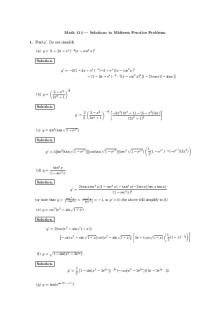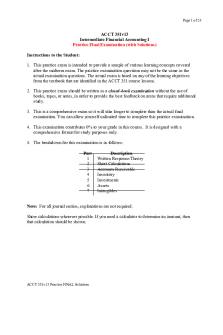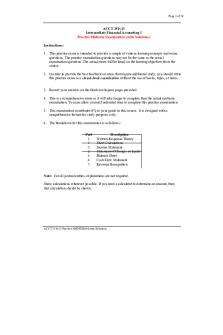Bond practice solutions udpated PDF

| Title | Bond practice solutions udpated |
|---|---|
| Author | Veronica Wong |
| Course | Corporate Finance |
| Institution | New York University |
| Pages | 16 |
| File Size | 341.1 KB |
| File Type | |
| Total Downloads | 1 |
| Total Views | 152 |
Summary
Bond practice question solutions...
Description
Bond
Instructor: Keke Song
Multiple Choices & True/False 1. Management may be tempted to make decisions that benefit themselves rather than the shareholders they represent. Management compensation, however, can be structured to better align management interests with shareholder interests. True or False Answer: TRUE One way to resolve the conflict of interest between management and shareholders is to use bonus and stock grants to align the interest of management with shareholders. But this strategy is not cost-free. 2. Which of the following is part of the investment decision? A. what dividend the firm should pay B. what fixed assets the firm should purchase C. how the firm should fund asset purchases D. how much cash the firm should hold Answer: B. Investment decisions or capital budgeting decisions are about what projects a firm should undertake. This type of decisions often involves the purchase of new non-current assets and will affect the left-hand-side of balance sheet (i.e. the asset side). 3. Capital structure is: A. the mix of debt and equity maintained by a firm B. the mix of short-term debt and assets held by a firm C. the mix of long-term debt and assets held by a firm D. the mix of dividends and debt maintained by a firm Answer A. Financing or capital structure decisions are about how to finance a firm’s projects. In general, a firm’s capital comes from only two general categories: debt and equity. This type of decisions will affect the mixture of debt and equity and therefore are also called capital structure decisions. 4. The process of planning and managing a firm's investment in non-current assets is known as: A. working capital management B. financing decision C. capital budgeting D. earnings decision Answer C. Investment decisions or capital budgeting decisions are about what projects a firm should undertake. This type of decisions often involves the purchase of new non-current assets and will affect the left-hand-side of balance sheets (i.e. the asset side of balance sheets). 5. The relationship between shareholders and management is called: A. an agency relationship B. a proxy relationship C. a managerial relationship D. both an agency relationship and an agency issue Answer A. Management is the agent and shareholders are the principal. The relationship between the two parties is called agency relationship. 1
Bond
Instructor: Keke Song
Agency issue refers to the conflict of interest between shareholders and management. 6. Agency costs refer to: A. the total dividends paid to shareholders over a period of 10 years B. the total interest paid to bondholders over a period of 10 years C. both the total dividends paid to shareholders over a period of 10 years, and the total interest paid to bondholders over a period of 10 years D. the costs or the conflict of interest between shareholders and management Answer D. Agency issue refers to the conflict of interest between shareholders and management. It can be direct (i.e. direct costs that will benefit top management but at the expenses of shareholders. E.g. a company purchases unnecessary corporate jets or luxury hotel/flights for its executives) or indirect (i.e. top management makes some corporate decisions for their own interest but at the expense of shareholders. E.g. a CEO decides to purchase another company to make his/her job safer). 7. As a financial manager should you be concerned with how to finance the purchase of a new factory? A. no B. yes, but only if we already have sufficient cash C. no, unless we need to borrow the money D. yes, we should decide how it is paid for Answer D. Financing or capital structure decisions are about how to finance a firm’s projects. In general, a firm’s cash comes from only two general categories: debt and equity. This type of decisions will affect the mixture of debt and equity and therefore are also called capital structure decisions. Capital structure decisions are one of the three major types of decisions a financial manager needs to deal with. Capital structure decisions are one of the three pillars of financial management. 8. The possibility of conflict of interest between the stockholders and management of the firm is called: A. The shareholders' conundrum. B. Corporate breakdown. C. The agency problem. D. Corporate activism. E. Legal liability. Answer C. The conflict of interest between shareholders and management is called agency problem or agency cost. 9. Capital structure refers to: A. The amount of inventory held. B. The amount of cash on hand. C. The mixture of debt and equity. D. The accounts receivable policy. E. The management of long-term investments. Answer C. 2
Bond
Instructor: Keke Song
Capital structure refers to the mixture of debt and equity. A, B and D refer to working capital management. E refers to investment or capital budgeting decisions. 10. A 7% Commonwealth government bond has three years to maturity. Given that the bond pays interest semi-annually (i.e. twice a year) and an interest payment has just been made, what is the present value of the bond if the YTM is 9% and the face value of the bond is $100 000? A. $88 693.18 B. $94 842.13 C. $101 522.78 D. $105 875.28 Answer B. For semi-annual coupon bonds, coupon rate and YTM are APR compounded semi-annually. Bond value = PV of coupons and FV. 𝐹𝑉 𝐶 1 • Formula: 𝐵𝑜𝑛𝑑 𝑣𝑎𝑙𝑢𝑒 = [1 − (1+𝑟)𝑇 ] + 𝑇 𝑟
•
(1+𝑟)
Excel: = PV(rate, nper, pmt, fv)
Step 1: find the inputs • FV= $100000 • C (pmt in Excel) = face value × coupon rate /2 = 100000× 0.07 /2=$3,500 • T (nper in Excel) = 3 years × 2 = 6 • r (rate in Excel)= YTM/2 = 0.045 o for semi-annual coupon bonds, YTM is an APR compounded semi-annually Step 2: compute bond value • Excel method: = PV(0.045,6,3500,100000) o bond value = 94842.13 o Note the excel will return a negative number. This is because we input the coupon (3500) and face value (100000) as positive numbers. Excel assumes we are bond investors and the bond value is the price we need to pay (i.e. cash outflow). • Formula method: 3500 1 100000 o 𝑃𝑉 = 0.045 [1 − ] + (1+0.045)6 = 94842 .13 (1+0.045)6 11. The coupon rate is best defined as the: A. annual coupon divided by the current price of a bond. B. periodic payment divided by the premium value of a bond. C. semi-annual interest payment divided by the market price. D. annual coupon divided by the face value of a bond. Answer D. The coupon rate is the ratio of annual coupon to face value of a bond. 12. The portion of a bond's yield that compensates investors for the possibility that the bond's interest or principal might not be paid is called the: A. interest rate risk premium. 3
Bond
Instructor: Keke Song
B. missed coupon rate. C. liquidity premium. D. default risk premium. Answer D. Default or credit risk is the risk that the bond's interest or principal might not be paid. Higher default risk means higher yield. Investors can earn an interest rate without taking any default risk by investing in default-risk-free bonds (i.e. government bonds). The default premium or credit spread is the difference between YTM on a corporate bond and that on a government bond. It is the compensation for bearing the default risk of the bond. 13. On which one of the following dates is the principal amount of a bond repaid? A. Coupon date B. Issue date C. Discount date D. Maturity date Answer D. The bond issuer should pay the face value on the maturity date. 14. When a bond's yield to maturity is less than the bond's coupon rate, the bond: A. had to be recently issued. B. is selling at a premium. C. has reached its maturity date. D. is priced at par. Answer B. If the YTM < the coupon rate, then the bond value is greater than the face value (the coupon rate beat the required rate of return on the bond; as a result, investors are willing to pay a premium). If the YTM > the coupon rate, then the bond value is smaller than the face value (the coupon rate does not match the required rate of return on the bond; as a result, investors need a discount on bond price as a compensation). If the YTM = the coupon rate, then the bond value = the face value. 15. Suppose you are trying to price a bond. Which of the following is false? A. The lower the discount rate, the more valuable the coupon payments are today. B. Bonds with high coupon payments are generally (all else the same) more sensitive to changes in interest rates than bonds with lower coupon payments. C. When market interest rates rise, bond prices will fall, all else the same. D. Bonds with long maturities are generally (all else the same) more sensitive to changes in interest rates than bonds with shorter maturities. E. All else the same, bonds with larger coupon payments will have a higher price today. Answer B. The statement in A is correct: lower discount rate means higher present value. The statement in B is incorrect: every else the same, the lower the coupon rate, the greater the interest rate risk. In comparison with face value, coupons are earlier payments and therefore have lower interest rate risk exposure. If coupon rate is lower, then the weight of coupons (smaller interest rate risk exposure) in total bond value is smaller, and the weight of face value (higher interest rate risk exposure) in total bond value is larger. Therefore bonds with higher coupon rates should have lower interest rate risk exposure (sensitivity to interest rate changes).
4
Bond
Instructor: Keke Song
The statement in C is correct: When market interest rate rise, the discount rate will be higher and bond prices will fall. The statement in D is correct: The PV of later cash flows are more sensitive to interest rate changes (i.e. higher interest rate risk exposure) than that of earlier cash flows. The statement in E is correct: if coupons are larger, then PV of coupons is larger. 16. All else equal, the market value of a corporate bond is always inversely related to its: I. time to maturity. II. coupon rate. III. yield-to-maturity. A. I only B. II only C. III only D. I and III only E. I, II, and III Answer: C I is incorrect. When coupon rate is greater than YTM, longer maturity means higher bond value. This is because longer maturity means more coupon payments; investors can enjoy the higher-than-market coupon rate for a longer period and therefore the bond value should be higher for bonds with longer maturity. II is incorrect. Higher coupon rate means higher PV of coupon payments and consequently higher bond value. III is correct. Higher YTM means higher discount rate, which means lower present value (or bond value in this case). 17. An unexpected decrease in market interest rates will cause a: A. coupon bond's time-to-maturity to increase. B. zero coupon bond's price to decrease. C. fixed-rate bond's coupon rate to decrease. D. coupon bond's yield to maturity to decrease. E. coupon bond’s price to decrease Answer D. A is incorrect: coupon bonds’ maturity is fixed. B is incorrect: if market interest rates decrease, then the YTM on a zero-coupon bond will move in the same direction. Then the bond value should rise. C is incorrect: fixed-rate bonds have fixed coupon rates. D is correct: if market interest rates increase, then a coupon bond’s YTM should also increase. Otherwise investors will not invest in the coupon bond since it does not offer a competitive yield. E is incorrect: if market interest rates increase, then a coupon bond’s YTM should also increase, and the bond value will drop due to higher discount rate. 18. Liddy Products, Inc. just issued 10-year, 8% coupon bonds at par. Outstanding Limbaugh Corp. bonds, which have a maturity of 10 years, sell at a premium and are viewed by investors as having the same risk as the Liddy bonds. Therefore, it must be true that: 5
Bond
Instructor: Keke Song
A. The coupon rate on the Limbaugh bonds is equal to that on the Liddy bonds. B. The coupon rate on the Limbaugh bonds is higher than that on the Liddy bonds. C. The coupon rate on the Limbaugh bonds is lower than that on the Liddy bonds. D. The yield on Limbaugh bonds is higher than the yield on Liddy bonds. E. The Limbaugh bonds pay coupons more often than twice a year. Answer B. o (1) If the two bonds have the same risk, then the YTMLiddy = YTMLimbaugh (otherwise investors will buy the bond with higher yield and eventually push down its yield to the equilibrium level). o (2) Liddy Products’ bonds are traded at par. Thus, YMTLiddy= Coupon rateLiddy. o (3) Limbaugh’s bonds are sold at premium. Thus, YTMLimbaugh...
Similar Free PDFs

Bond practice solutions udpated
- 16 Pages

Bond practice
- 8 Pages

Bond worksheet - bond answer
- 17 Pages

Practice Solutions
- 71 Pages

Midterm Practice 1 Solutions
- 9 Pages

Practice Test 1 - Solutions
- 21 Pages

Practice 1 - Solutions - Seminar
- 5 Pages

Practice Final solutions
- 24 Pages

All Practice Set Solutions
- 21 Pages

Pset 10 solutions - practice
- 11 Pages

Practice Midterm Solutions
- 20 Pages

HW1 practice solutions
- 11 Pages

HW4 practice solutions
- 6 Pages

Solutions - Practice Question
- 56 Pages
Popular Institutions
- Tinajero National High School - Annex
- Politeknik Caltex Riau
- Yokohama City University
- SGT University
- University of Al-Qadisiyah
- Divine Word College of Vigan
- Techniek College Rotterdam
- Universidade de Santiago
- Universiti Teknologi MARA Cawangan Johor Kampus Pasir Gudang
- Poltekkes Kemenkes Yogyakarta
- Baguio City National High School
- Colegio san marcos
- preparatoria uno
- Centro de Bachillerato Tecnológico Industrial y de Servicios No. 107
- Dalian Maritime University
- Quang Trung Secondary School
- Colegio Tecnológico en Informática
- Corporación Regional de Educación Superior
- Grupo CEDVA
- Dar Al Uloom University
- Centro de Estudios Preuniversitarios de la Universidad Nacional de Ingeniería
- 上智大学
- Aakash International School, Nuna Majara
- San Felipe Neri Catholic School
- Kang Chiao International School - New Taipei City
- Misamis Occidental National High School
- Institución Educativa Escuela Normal Juan Ladrilleros
- Kolehiyo ng Pantukan
- Batanes State College
- Instituto Continental
- Sekolah Menengah Kejuruan Kesehatan Kaltara (Tarakan)
- Colegio de La Inmaculada Concepcion - Cebu

